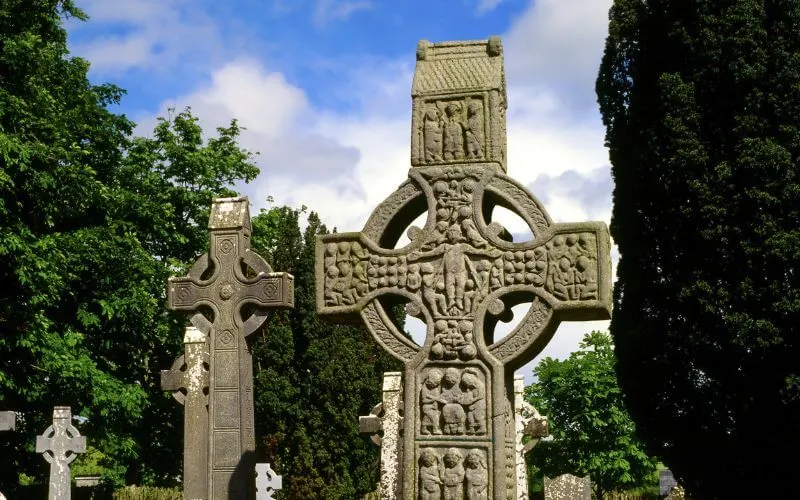
While there are many different cross types, the Celtic cross stands out as being one of the most recognisable and iconic.
Examples of these remarkable sculptures dating back over a thousand years are found scattered in several regions in western Europe such as Scotland and Wales, with a high density of superb examples found in Ireland.
You may be familiar with the Celtic cross symbol as a piece of jewelry, tattoo or even as a gravestone design, but do you know the meaning behind or interesting history behind the symbol?
This article will let you explore the evolution of the Celtic cross design, as well as take a tour through the history, function and meanings associated with these impressive ancient sculptures.
Table of Contents
What is a Celtic Cross?
The term Celtic cross is used to describe a type of ringed cross based on the design of the Latin cross. The vertical beam at the base is considerably longer than the three arms at the top, which are roughly equal in length.
Early Celtic cross design originated from basic cross slab forms to the elaborate and architecturally impressive high crosses that represent the pinnacle of Celtic cross development.
Most Celtic high crosses, especially those found in Ireland, usually have the characteristic ringed shape of the Celtic cross. To find out more about high crosses, particularly Irish high crosses, read here.
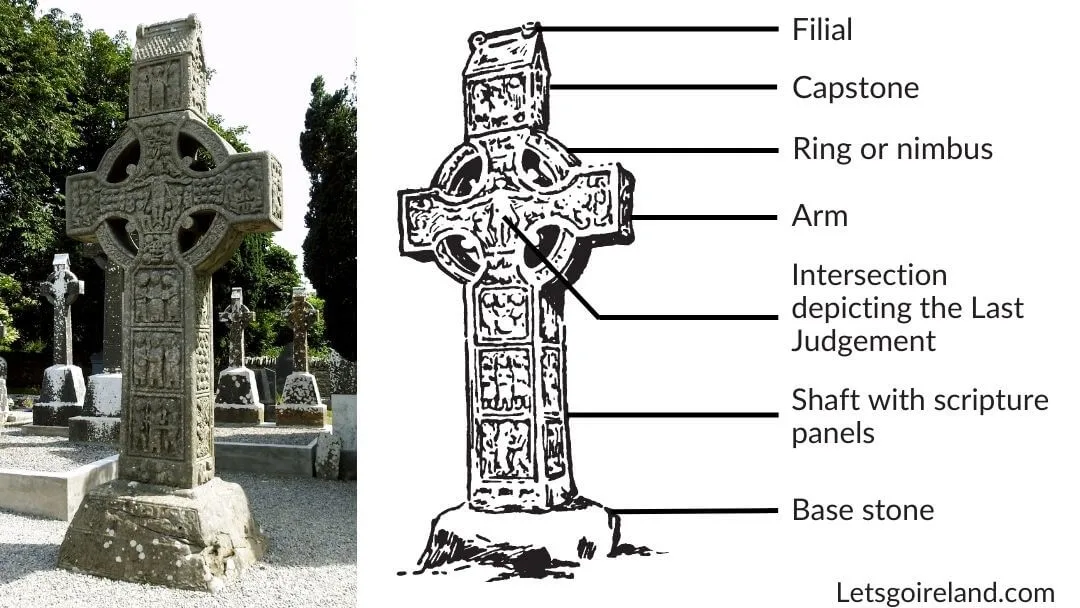
Generally speaking, Celtic high crosses integrate four key design elements in their structures.
- A base stone is typically present at the foot of a cross, but not in all cases. The base stone forms the foundation where the vertical beam is set into a specially carved hollow and secured by a tenon joint.
- A ring, or nimbus, surrounds the intersection and upper arms of the cross. It also forms an important structural component of the cross. Importantly, the arms of the cross extend beyond the central ring, thus differentiating it from the sun cross or solar cross.
- At the top of the cross a decorative capstone is sometimes present. These carved stones frequently have slanted sides, possibly as a protective feature to minimize the impacts of weathering.
- Usually high crosses were highly decorated with elaborate human and animal imagery or Celtic knot patterns. These carved illustrations were particularly useful for explaining biblical stories to the illiterate population.
Celtic Cross Meaning
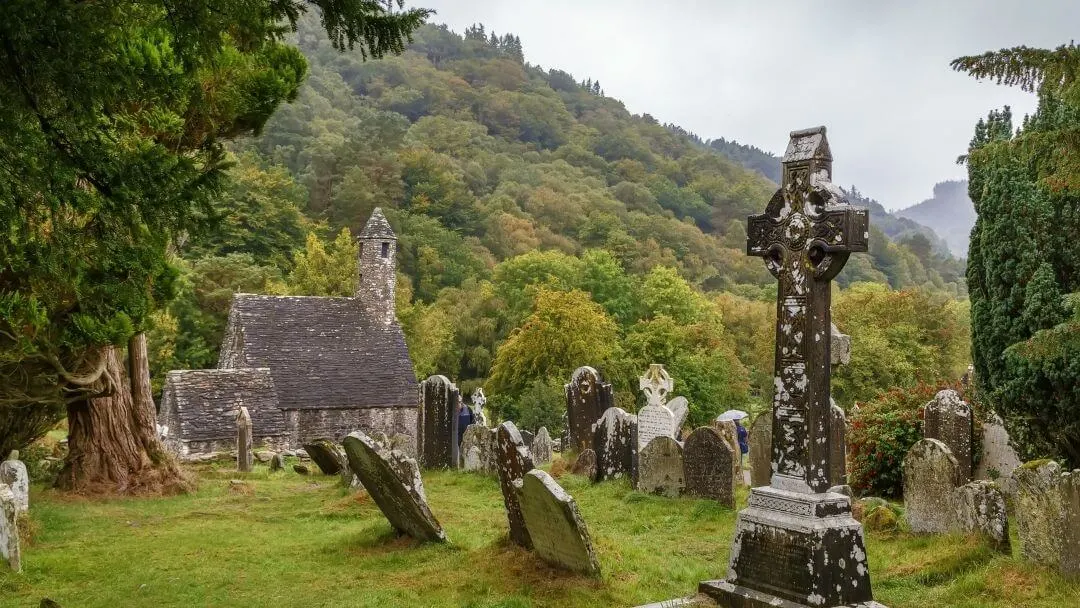
The precise meaning of the Celtic cross design is difficult to say with complete certainty, but there are several theories behind its distinctive design.
First of all, there has been much debate about the ring feature.
Some suggestions thought to date back to the time of the Celtic Revival, put forward the idea that the ring design evolved from, or was inspired by the ancient, pre-Christian sun cross symbol.
The sun cross (also known as a solar cross or a wheel cross) can trace its origins back several thousand years to the Bronze Age in Europe, when sun god worship was more common practice.
Alternatively, the meaning of the ringed cross has been connected with the concept in Christianity that a circle represents oneness, eternity or never ending love. Some suggestions have even pointed to the idea that the ring could represent a halo or symbolize the cosmos and central importance of the crucifixion.
However, on a practical note, the addition of a ring to the cross is likely to be more functional than meaningful.
In order to create a stable structure, a ring is a necessary design feature. It provides extra reinforcement for the arms of the cross and supports the entire structure.
Here are some of the unproven suggestions as to the meaning of the Celtic cross:
The Celtic cross can be seen as a form of compass with the four cardinal directions of north, south, east and west represented by the arms of the cross.
Other similar, (probably quite modern) suggestions that have been put forward connect the arms of the cross with the elements of fire, air, earth and water or mind, body, soul and heart.
There are even stories that attribute the design of the Celtic high cross to Saint Patrick, who was said to have defaced a druidic standing stone by drawing a cross through the circle on it. If this is true, he clearly was way ahead of his time artistically!
History of the Celtic Cross and Celtic High Cross
The history of the Celtic cross is a complex one that more than likely evolved from the early basic cross ornamentation to the Celtic high crosses that we are more familiar with today.
Early Celtic Crosses
The use of crosses as a design feature in Celtic art has been found as far back as the Hallstatt (ca. 1200 – 500 B.C.E.) or La Téne (ca. 450 – 1 B.C.E.) periods.
These crosses were not the free standing sculptures that we commonly associate with Celtic high crosses. They were engravings of sun crosses and diagonal crosses (known also as St. Andrew’s Cross) that were used decoratively on metal work for example.
From around the 6th century onwards, as Christianity gained popularity in western Europe, new developments in Celtic art began to appear in Britain and Ireland.
Development of Celtic Crosses
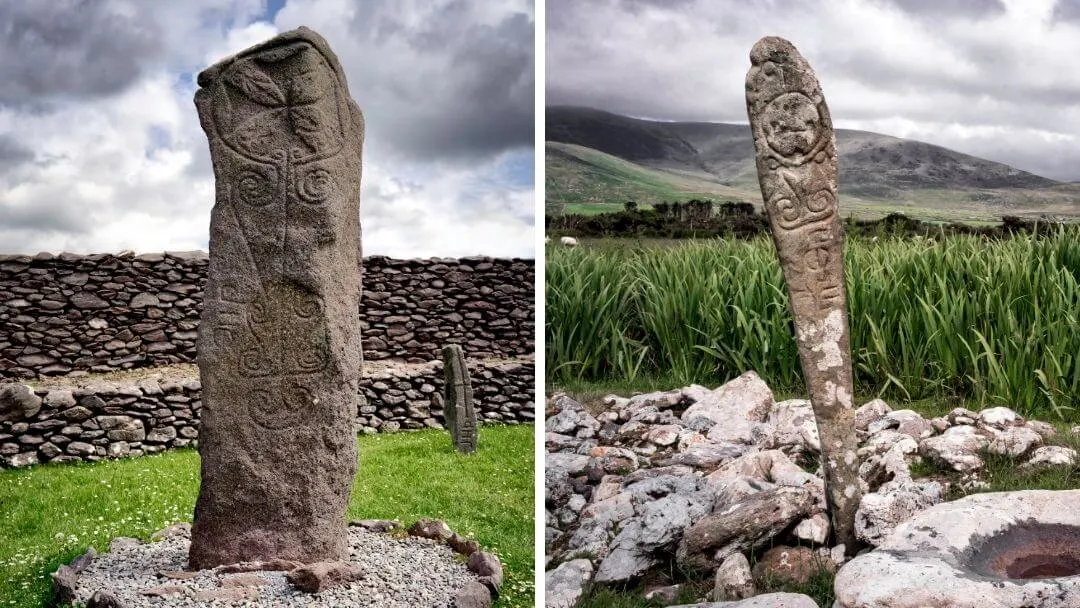
During the time of Celtic Christianity, the Hiberno-Saxon art, or Insular art, which features human and animal imagery and ornate Celtic knotwork developed in Ireland and Britain.
The illuminated manuscripts of Book of Durrow (ca. 650 C.E.) and the Book of Kells (ca. 800 C.E.) are some of the most well known examples of this art style from this time
Advancements in the Celtic art style also found their way into the design of stone crosses.
Some of the earliest surviving examples of stone crosses dating back to the late 6th century are relatively simple in design.
For example the Riasc Pillar on the Dingle Peninsula. It consists of a stone slab with a cross inscribed into it.
Over time, the form and carving techniques became more advanced and these Christian cross designs became progressively more elaborate.
During the 7th century, some stone slabs were carved into the shape of a cross. This was followed by advancements to the in-depth relief design around the 8th century.
High Cross Sculpture
The appearance of a ring in the cross design started around the 9th century. This heralded the start of the period of high crosses, which lasted until the 12th century.
These massive structures are sometimes up to 7 meters tall (ca. 22 ft).
Early crosses from this period have ornamental Celtic knotwork and interlace patterns, such as the Ahenny High Crosses in County Tipperary.
The inclusion of figures depicting biblical stories appeared later around the late 9th and 10th century.
Some of the most famous of all high crosses date from around the 10th century.
Around this time the style of the high crosses changed.
For example, the size of the high crosses became bigger and often more chunky or massive in design, while greater focus was placed on the arrangement of the iconography used to explain the biblical stories.
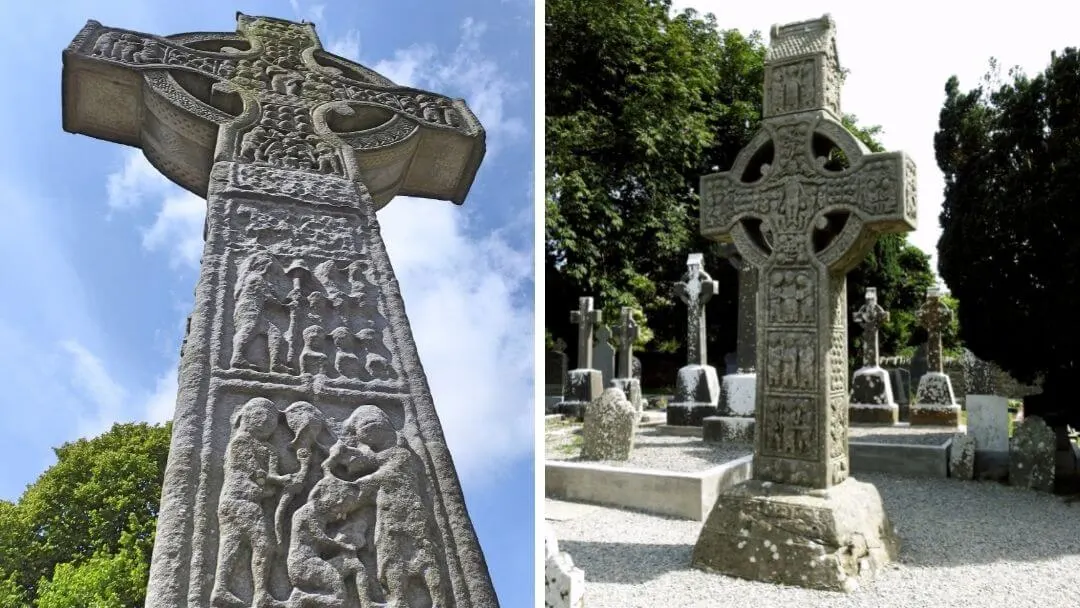
The old monastery in Monasterboice, County Louth is home to a round tower and three excellent examples of high crosses, including the West Cross standing 7 meters tall (ca. 22 ft).
Muiredach’s Cross (or the South Cross as it is also known) is another cross on the site.
Its impressive size and incredibly detailed panels of biblical scenes carved in very high relief make it one of the best examples of high crosses.
A selection of biblical figures and scenes from both the Old Testament and New Testament adorn the high relief panels.
A depiction of the Last Judgement is shown on the east face.
Scandinavian design may have played a role in influencing the design of crosses dating from the 12th century.
When the focus shifted away from the narration of stories and the primary relief figure of Christ or a local religious official.
Another distinguishing feature is that the ring is often smaller in size than the crosses from the previous centuries.
During the 9th to the 12th century, there were periods when very few crosses were made, notably the 11th century.
However, after the spurt of activity in the 12th century the production of crosses dramatically declined.
There is evidence that on the island of Iona, off the coast of Scotland, high crosses were made as late as the 15th century.
The McLean cross is one such example.
Celtic Revival
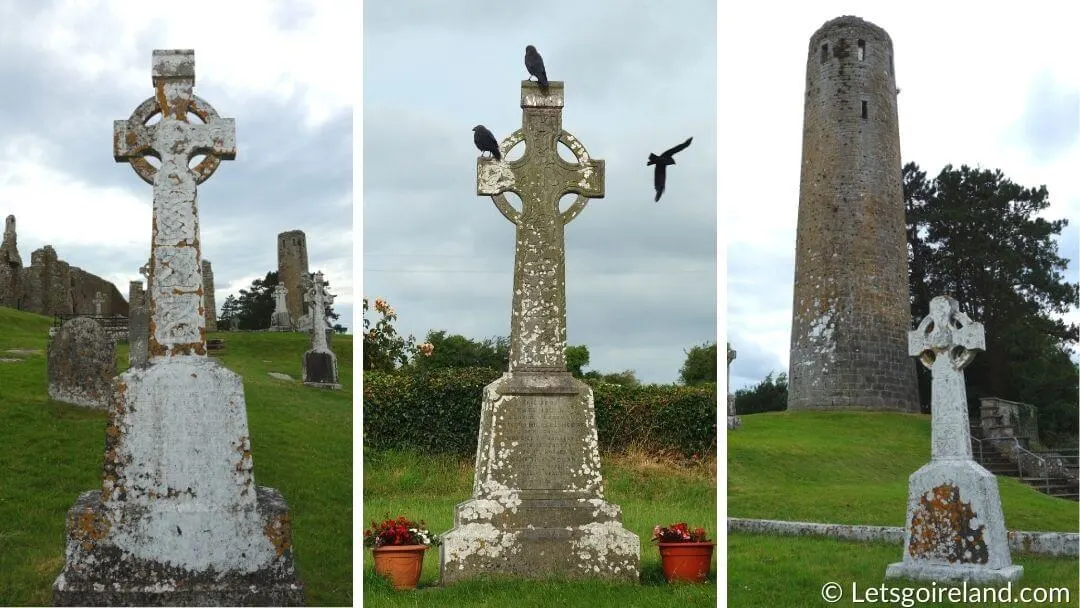
The renewed interest in Celtic culture as part of the Celtic Revival that started in the 19th century created a newfound appreciation of Celtic crosses.
During the Early Medieval Period, Celtic crosses were not used to mark burial places, however after the Celtic Revival tombstones in the form of high crosses were introduced.
These tombstones which can be ca. 2 meters tall (6.5 feet) can be seen in many old graveyards, particularly in Ireland.
These relatively modern Celtic crosses usually feature Celtic knots and interlace patterns and do not include panels of narrative scenes similar to the high crosses from the ca. 10th century.
Function of Celtic Crosses
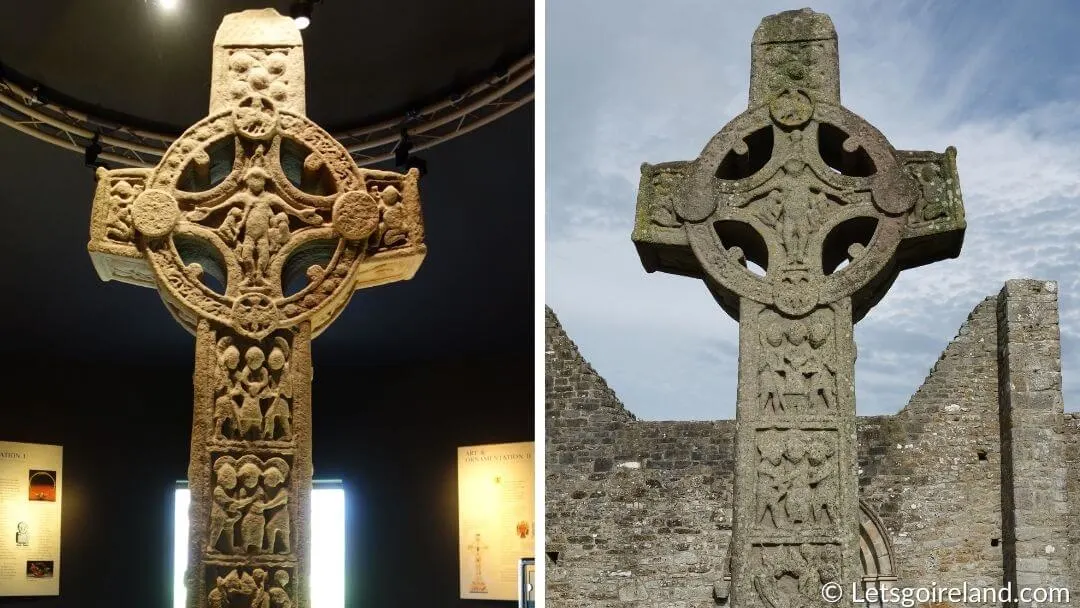
Given the scale and elaborate nature of the Celtic crosses, as well as the significant resources such as cost, knowledge and skills required to complete them, it is likely that these crosses served multiple functions.
Celtic Crosses as Status Symbols
Firstly, as many crosses are often found in and around the remains of old monasteries, it is essential to understand the importance of monasteries at this time.
Monasteries grew in size during the 7th and 8th centuries and were places of prayer and worship.
They also acted as focal points for the entire communities that settled around them, especially from around the 9th century onwards.
As centers of trade, learning and power, monasteries undoubtedly had significant political standing and were often supported by the local king.
It is not surprising then that some crosses were commissioned as memorials, or as monuments dedicated to prominent individuals such as an abbot or local king (as is likely in the case of Muiredach’s Cross in Monasterboice).
Thus these crosses functioned as an important symbol of authority, status and power.
Celtic Crosses as Educational Tools
Another function relates to the use of detailed iconography on the panels of the crosses, which points to the use of the crosses as an educational tool.
Given the complex nature of some of the scenes, it is possible that the crosses were used not to teach the bible from scratch, but as tools to enhance further knowledge and understanding of the bible to people familiar with the stories.
While it may be difficult to decipher some of the scenes today, crosses may have been colorfully originally painted so it would have been easier to see the individual depicted scenes.
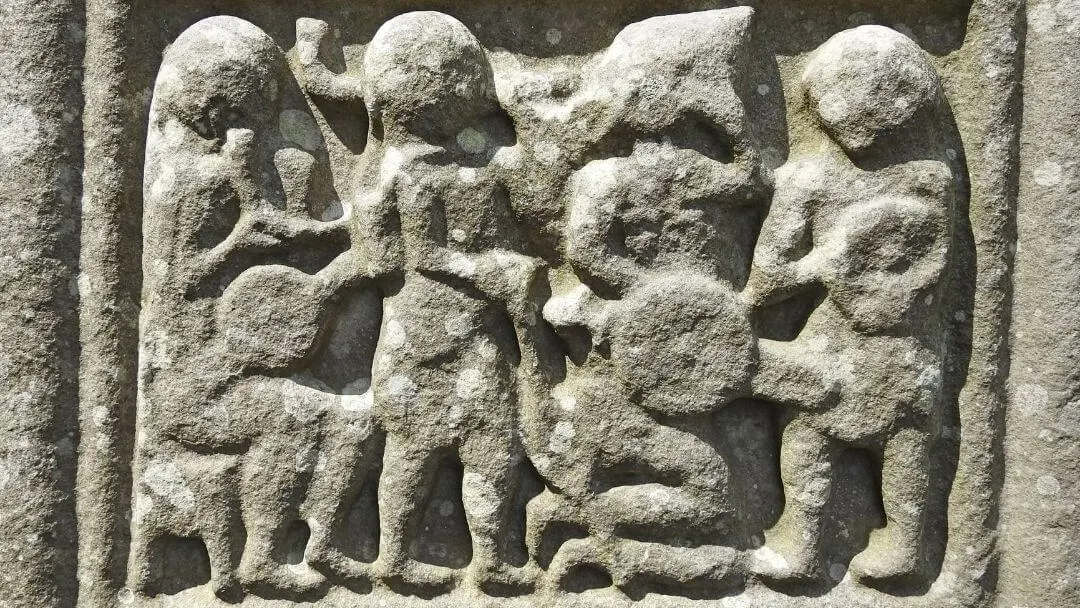
Pollution, as well as the natural weathering processes that stone undergoes when exposed to wind, rain and changing temperatures has damaged some crosses and ensured that all traces of paint no longer exist.
Some high crosses have been placed indoors (Cross of the Scriptures in Clonmacnoise, County Offaly) or under protective shelters (Cross of Moone, County Kildare) to limit the damage.
How to best preserve the remaining outdoor crosses is still an ongoing debate.
Celtic Crosses as Boundary Markers
Celtic crosses were sometimes used to mark the boundary lines or even perhaps sacred areas.
The Castlekeeran High Crosses in County Meath are quite plainly decorated and thought to have acted as boundary markers, otherwise known as termon crosses.
It is likely that such a large sculpture as a high cross may have had several functions and not just one.
What is clear though is that crosses from the Early Middle Ages were not used to mark burial areas.
Celtic Cross Symbol
Depending on who you ask, the Celtic cross symbol has many associations.
The Celtic cross spiritual meaning is very important for some people, while others associate the symbol more with Celtic culture or Irish heritage.
Celtic Cross Ireland
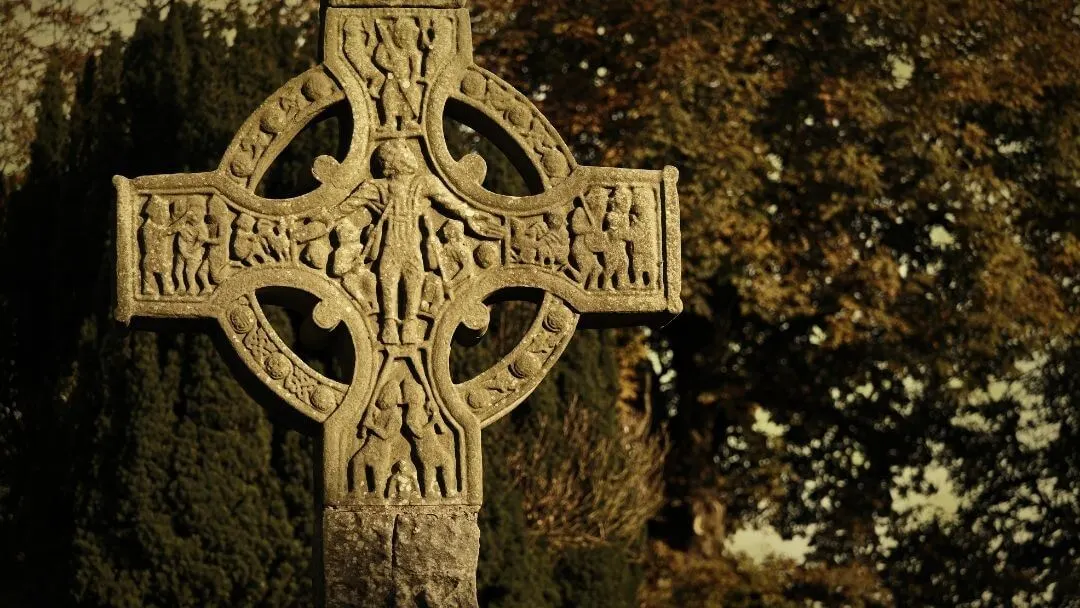
Ireland has undeniably connection with the Celtic cross symbol through the significant contribution to the design of Celtic crosses that took place on the island during the Insular art period.
Not only are many of the most remarkable high crosses found in Ireland, Irish Celtic crosses also illustrate some of the finest examples of stone carving and Irish art from this period in Europe.
It should come as no surprise then that they are also occasionally known as the gaelic cross.
Find out more about High Crosses with Irish examples and other Irish Symbols.
Celtic Cross Jewelry and Souvenirs
A Celtic cross necklace or Celtic cross ring will always be an eye-catching piece of Celtic jewelry, but the meaning and symbolism behind this Christian symbol with ancient Celtic roots lies far deeper for many people.
For example, wearing silver or gold Celtic cross jewelry can, but is not always connected with a person’s faith or cultural heritage.
The Claddagh cross, which features a cross with the Claddagh symbol instead of the typical Celtic cross ring, is one modern design that merges the two ideas of faith and Irish culture.
(Before you shop for Claddagh rings, which are sometimes used as wedding rings, be sure to read the meaning of the Claddagh ring here.)
Many Irish souvenirs for the home also display the Celtic cross designs, such as wall plaques and blessings in the form of a Celtic cross made of Belleek pottery or Connemara marble.
Celtic Cross Tattoo
For some people, a Celtic cross tattoo enables them to permanently connect with their religious beliefs or cultural heritage. Or perhaps they just really like the Celtic cross design.
Whatever the reasons, the Celtic cross is one of the most popular Celtic tattoo design motifs.
Often, elements of Celtic knotwork such as Trinity knots and Triskeles are integrated into the design resulting in a Celtic knot cross tattoo.
Before you decide to get anything permanently inked on your body, please do some thorough research as to the meaning to make sure you are happy with your choice! This is particularly true for all Celtic tattoo designs.
If you want to discover more about high crosses and some stunning Irish crosses in particular, then this is the post for you!
This post may contain affiliate links.If you click on one of them, we might receive a small commission (at no extra cost to you). Thank you for your support.
